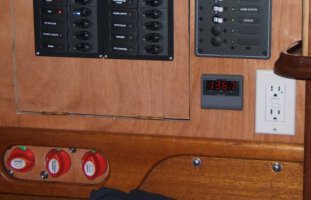Mort Fligelman
Member III
I followed the instructions concerning the "uncoupling" for lack of a better term, of the glow plug and starter button on my E-35-3, along with the other change to a heavier wire on the alternator, and noted that the ammeter would not read to correct current.
I am one that has never been comfortable with an "Idiot Light" on an automobile, or a boat....and right now it seems to me that is all the ammeter on my boat is.
Has anyone installed an additional ammeter, either in the cockpit, or below in the area of the distribution panel?
Comments would be appreciated.....a soloution would be better...
I am one that has never been comfortable with an "Idiot Light" on an automobile, or a boat....and right now it seems to me that is all the ammeter on my boat is.
Has anyone installed an additional ammeter, either in the cockpit, or below in the area of the distribution panel?
Comments would be appreciated.....a soloution would be better...

